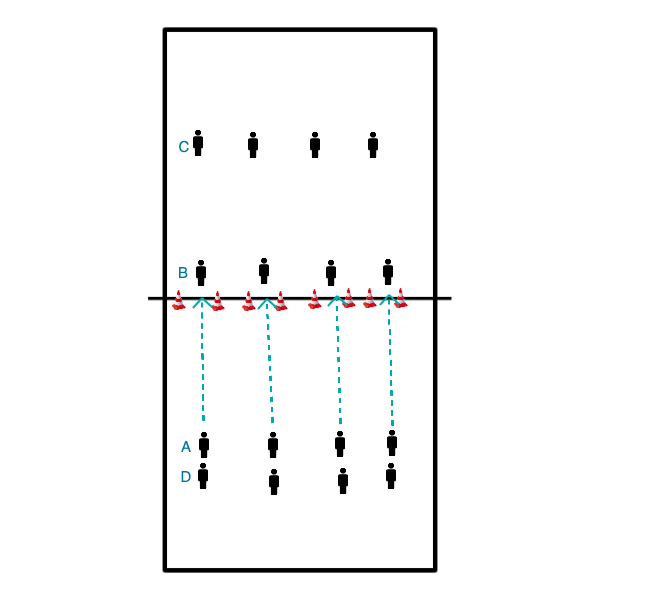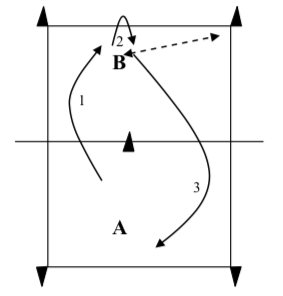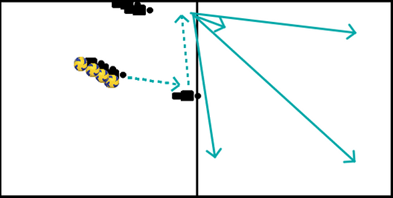Volleyball drills for technique setting / overarm technique
Setup: Each player has a ball.
Everyone walks through each other, bouncing a ball, and carries out the following tasks.
Signals + command
- On 1: bounce the ball to the right.
- At 2: bounce the ball to the left
- At 3: ba with both hands on collision
- Follow your way with the other hand.
- Pick up the ball with 1 or 2 hands after bounce
- Leave your own ball behind after bounce as quickly as possible to intercept another ball
More leaning towards keys:
- After dribbling ball catch own ball above head, then throw ball into air again without letting ball drop under eyes.
- Same as before, hold for 1 second
- Same as first, shorten contact
- Idem, but first catch the ball, then touch it away
- Ditto, but with double key
Game Form 1B:
During:
- The serve: the ball is thrown into play with both hands.
- Catching the ball with both hands above the head.
- Throwing the ball in front of himself (without dropping below the level of the eyes) and then overplaying it with an overhand touch.
Next:
- 2 feet out of the field, where the player wants: left - right - back
- Variation: touch a cone each time the ball crosses the net.
Notes:
- Throw the ball back where you caught it (do not run with the ball in your hands).
- Do not hold the ball in your hands for more than 2 seconds.
- Standing still when the ball is caught (and perhaps aiming).
Form 1C:
During:
- Picking the ball out of the air with one hand, making one collision and a second collision through a basketball dribble with one hand, high enough to play overhead. (One or two control keys may be used to play).
- Picking should be done as high as possible.
Next:
- 2 feet out of the court, where the player wants (left - right - back)
- Variant: move one of the two tennis balls placed on the 2 cones (at the back of the field).
Formation: 2 balls per 4 players

1.
- Player A (bowling motion) rolls the ball to player B (the ball must pass between the 2 cones!!).
- Player B picks up the ball, bounces it 2 times and then plays it in a bow to player C.
- Player C holds a hoop and puts the hoop down at the spot where the ball is going to collide. The ball is caught after 1 collision. Player C grabs the ball and joins player D at the back.
- Everyone follows their ball = moves up one place.
2.
- Player A throws the ball under the net to player B.
- Player B catches the ball, bounces once high, does a control key and then bounces to player C.
- Player C catches the ball low to the ground in the correct reception position and runs to D to join the back of the line.
- Everyone follows their ball = moves up one spot.
3.
- Player A throws the ball (bowling motion!) over the net to player B.
- Player B plucks the ball out of the air, bounces 3 times (must turn around during those 3 bounces to face player C) and then tips the ball to player C.
- Player C does reception for himself and joins player D.
- Everyone follows their ball = moves up one spot.
4.
- Player A calmly strikes the ball underhand over the net to player B.
- Player B plucks the ball out of the air, does 1 control bounce, then does control keys until fully turned facing player C and then plays the ball player C.
- Player C does reception for himself, catches the ball and joins player D.
- Everyone follows their ball = moves up one spot.
In a line-up with 2 players facing each other, key the ball over the net after 2 dribbles and 1 high rebound.

Possible variations:
- Play the ball after bumps
- Playing the ball after picking
- Playing the ball after catching without bots
- Play with 2 balls
Note: depending on the level we can differentiate and let the better players play with a handicap.
variation on Kings Court: winners move to winners field, losers move out and 3 new players move in.
- 3 players per half (whole field)
- trainer puts 1st ball in field of new team
- max 2 plays per half
- no smashing, no jumping, no lobs
- communication per team is a necessity
- The whole field must be defended (is feasible).
- balls coming from the other side are not hard but placed.
- there's a line,
- they throw the ball to the playmaker,
- who plays the ball to the attacker.
- who plays(!) not hit. over the net.
- Later you can attack.

- 2 players with backs to each other with ball
- A stands on backline runs to net gets high ball thrown to bra over net.
- Walk backwards around the pawn on the backline and forward again to play the high ball over the net.
- Side pass to side to other half 2 balls.
Pairs;
- A cone; catching the ball at the right height
- Catch the ball at the right height and throw it back.
- Throw the ball up, fellow player plays it back overhead.
- Pass the ball overhead to each other; stop if it is not correct.
- Play the ball for yourself overhead,
- if it goes well, only do it underhand,
- and later on alternate
With this exercise the players learn to play 'smart'. just over the net or in the back corners
Per 2:
- Player A stands at the net, player B lies on the 3-meter line.
- At the moment player A throws up the ball to test, player B stands up.
- Player A plays BH to player B, player B does OH to player A.
- Player A gives a pass to player B, player B tries to play into a hoop.
The hoops represent the number of shots that must be drunk.
- Hoop 1 = 1 shot
- Hoop 2 = 2 shots
Variation 1
: Player A plays the first ball via a technical attack.
Variation 2:
Player B plays the ball with a hard overhead contact over the net.
- 2 teams (6,8,10 or 12 players)
- 1 person in the field (inside 3m line).
- Other players stand behind the 3m line in the waiting room.
- T puts ball in play in field A or B.
- You may only play the ball overhand within the 3m line.
- After playing the ball step out and someone in the waiting room takes your place.
- If you make a mistake, make sure you have the ball safe and encourage your teammates.
- If all the players of a team are eliminated, you have a point.
- Idem only underhand play
- idem overhand play only outside the 3m line
- variation on Kings Court with 3 players per team:
- only play overhand and play over the net,
- all 3 players of the team have to play 1 time
- and there is a second ball in the team which has to be passed between the 3 players of the own team (to play bra).
- Trainer brings ball easily to the new team.
- Every ball on the ground is a foul.
- Tactics (where to play the ball),
- bra technique,
- communication between the players.







